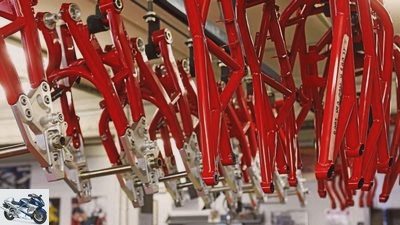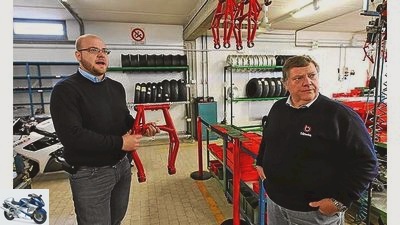Table of contents
- This is how one of the smallest manufacturers in the world produces Motorcycle construction at Bimota
- Creative, exclusive, expensive

Jahn
counselor
traffic & business
Motorcycle production at Bimota
This is how one of the smallest manufacturers in the world produces
Motorcycle construction at Bimota
In the second part of the series on motorcycle production, the number of items remains in three digits and the number of employees in two digits. Bimota is one of the smallest manufacturers in the world, motorcycles are more handcrafted than industrially produced there.
Ralf Schneider
02/17/2011

The prototype workshop of the traditionally innovative small manufacturer.
Before Ignazio Fancello starts assembling a series of Bimotas, he’s gone first. He goes to collect parts. Little by little he fills the shelves and tables on the first floor of the small factory building in Via Giaccaglia 38 in Rimini with panels, fenders, brake calipers and cables. He dumps swingarms, screws, nuts and washers of all kinds on the ceiling into the sorting boxes on a wall of shelves on rollers, then fetches the motor.
Buy complete article

This is how one of the smallest manufacturers in the world produces
Motorcycle construction at Bimota
5 pages) as PDF
€ 2.00
Buy now
Right next door are the freshly delivered Ducati engines in transport racks next to each other; They are rolled on a small lift truck to one of the five assembly stands in the production area, then Ignazio hangs a motor on a small crane, lifts it up and places it on the stand. This time it is an air-cooled two-valve engine, intended for the first of 25 Tesi 3D. This is the normal batch size at Bimota. The red-painted rear swing arms of the db7 and the Tesi, which are suspended from a ceiling beam, are the first thing visitors notice. Head of Development Massimo Gustato proudly shows the brake calipers that Grimeca makes especially for the Tesi with the Bimota logo.”Brembo didn’t want that, they don’t even do it for big manufacturers, I think, and certainly not for us.”

The all-rounder at Bimota: Ignazio Fancello
The Tesi small series that Ignazio has just started replaces a series of db8s that are awaiting completion next door, on assembly stands or already on their own wheels. “Moto da completare”, motorcycle to be completed, announces an attached routing slip in a transparent cover. The omega-shaped aluminum parts milled from solid are already arranged on a trolley, which – screwed to the engine – form the core of the unique chassis with kingpin steering. Ignazio does not use a pneumatic screwdriver to tighten the long bolts; he does this conventionally and carefully with a torque wrench. He can take his time. Production is at Bimota not divided into individual work steps, each of which is then optimized for itself. Here the principle applies: one man builds a motorcycle. There are plans to label the motorcycles with the name of their fitter in the future.
The second reason that Ignazio can take his time is less gratifying than the fact that the small motorcycle manufacturer relies on the work of highly qualified mechanics for production: Sales fell dramatically during the crisis. “In 2008 we built and sold 400 motorcycles, in 2010 it will be a maximum of 200. I would be happy if we could reach that number by the end of the year; At the moment (December 9, 2010, ed.) we are at 180. It is a black year”, says Massimo. That is also the reason why Ignazio works alone today. At weddings, two colleagues work with him to screw the exclusive Bimotas together, while three others take care of the pre-assembly of individual components, for example pulling the tires onto the newly introduced OZ wheels and fitting them with brake discs. The comparatively inexpensive db8 with Ducati 1198 engine, presented in autumn 2010, the same chassis as the db7, but with a simpler GRP instead of carbon fiber cladding, is expected to pull sales figures up again.

In the test department, the developments are checked by Ingeniere Gustato.
Maybe that’s why Ignazio leaves the Tesi, which has just been laid down, and turns to a half-finished db8. It is more likely, however, that he does not want to assemble and adjust the highly complex mechanics of the Di-Fazio front wheel hub under observation by the MOTORRAD photographer and editor, but in peace. In contrast, the installation of the rear wheel and the adjustment of track and chain slack on the db8 are pure routine. The assembly of the throttle valve body, including the air filter and airbox, which he then tackles, is also quick and easy. Pressed briefly and forcefully, the connectors pop into their lightly greased rubber sockets, and the clamps are quickly tightened. Each completed work step is faithfully entered in a routing slip.
Bimota developed the airbox and exhaust of the db7 / db8 models, and therefore also the injection software, in collaboration with the Walbro company. The modified set-up has made the Ducati engine more drivable, it is a bit softer and it behaves less aggressively when accelerating. A pleasant characteristic not only for the country road, but also for the racetrack, as the author was able to determine at an earlier date and MOTORCYCLE tests have confirmed.
As a small manufacturer with a minimal development budget, Bimota could not and cannot afford to develop its own motor, let alone manufacture it. The attempt to bring the 500cc two-cylinder two-stroke engine with direct injection as a drive for the Vdue to series production, led to bankruptcy. Especially since the simultaneous increase in production to up
900 motorcycles a year did not create the hoped-for capital base, but brought massive quality problems with it. Today, in the best company tradition, the company is mainly active as a chassis and design developer and leaves the maximum production capacity at around 600 units per year. Apart from the fact that an increase would be pointless at the moment, it would require a disproportionately high investment even in times of good economic activity. As not only shown by the company’s own history.

Pure routine: installation of the rear wheel and adjustment of track and chain passage.
The Bimota involvement in the Moto2 class, where various chassis manufacturers compete with Honda standard engines, should therefore not be understood as an adventure, but as an investment with the aim of receiving one or the other contract to build a chassis. But apart from three suspension kits that the German motorcycle dealer Denis Hertrampf ordered to build super classy racetrack motorcycles for wealthy collectors, this hope has not yet come true. The machines on the ground floor used to be used to manufacture the turned and milled parts, the finish of which Bimota is famous for is. Today only parts for racing machines or prototypes are produced there. They are tested on the road and on load test benches next door. When the final design is certain, Bimota orders the series parts from a specialist company. The same applies to the steel tubular frame segments, which are welded at Verlicchi, and the cladding parts.
Today, Bimota is purely a development and assembly company. The traditionally innovative small manufacturer wants to provide impetus for the use of carbon for load-bearing parts. This is demonstrated by the db7 oronero, whose frame saves around eight kilograms in weight where the standard version has a steel cane structure with carefully wound and glued carbon tubes. Will that last?? “Of course, on the racetrack we have even tested frames with a carbon segment that was half the weight”, says chief developer Massimo. “Without problems. But we build in reserves for normal operation.”
And how many people are “weather”? “Currently 25. In addition to the six people in production, there are two developers and a designer, a milling specialist, three people for sales, spare parts and warranty processing. And then we currently have three freelancers for a special project.” Unfortunately, there was no trace of it to be found when we visited MOTORRAD.
Creative, exclusive, expensive

Next to the motorway, near the Rimini Sud junction: Bimota-Manufaktur
If Massimo Tamburini’s Honda CB 750 hadn’t wobbled so miserably while driving on the Misano GP circuit, Bimota would probably never have existed. So, in addition to a suitable chassis for the Honda, the idea of founding a motorcycle manufacturer was born, which packed a wide variety of engines in high-quality chassis and exciting designs. In 1973 the time had come; the initial syllables of the founding names Bianchi, Morri and Tamburini formed the company name. The most successful Bimota construction to date, the groundbreaking YB4 with one of the first aluminum bridge frames in motorcycle construction, was created in 1988. The numbers have always remained low and the prices high; an attempt to expand in order to raise the development costs for a revolutionary two-stroke engine led to bankruptcy in 2000. In 2003 new investors brought the company back to life, today it only builds motorcycles with air and water-cooled engines from Ducati.
Related articles
-
Motorcycle production, part 1: Honda
Jahn 15th pictures Jahn 1/15 How are motorcycles produced? Where do the parts come from, what happens before final assembly? These questions urged…
-
Spotlight on motorcycle production, part 3: BMW
Bilski 13th pictures Bilski 1/13 A location with tradition – the oldest halls of the Spandau plant have been in existence since 1928, and since 1939 it…
-
Schwab Sports & scene History of motorcycle tuning History of motorcycle tuning Tuners have never had it harder Content of About 50 years ago, motorcycle…
-
www.bilski-fotografie.de 16 pictures Breutel 1/16 Entrance to the new, much smaller Bimota plant. Breutel 2/16 Left: Bimota owner Chiancianesi with the…
-
fact motorcycles Report: motorcycle design Motorcycle design Ugly or beautiful? Why do we like a motorcycle at first glance and not another one at first…
-
Motorcycle production country Thailand: Ducatis now also from Thailand?
Ducati counselor traffic & business Motorcycle production country Thailand: Ducatis now also from Thailand? Thailand is the number 5 motorcycle…
-
Motorcycle safety yesterday and today
Security campaign Consideration has right of way Arnold Debus Motorcycle safety yesterday and today Motorcycle safety yesterday and today lead by…
-
Scene: motorcycle legends and their situation today
MZ Sports & scene Scene: motorcycle legends and their situation today Scene: motorcycle legends and their situation today What are actually doing……
-
Portrait of a motorcycle enthusiast
Detlev Louis motorcycles Portrait of a motorcycle enthusiast Portrait of a motorcycle enthusiast The person behind Detlev Louis Dozens of shops bear his…
-
Manufacturer statements on the subject of motorcycle noise
Motorcycle noise Debate about the volume of motorcycles Astrid Gast – stock.adobe.com counselor traffic & business Manufacturer statements on the subject…